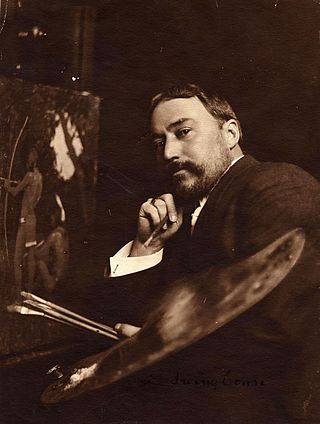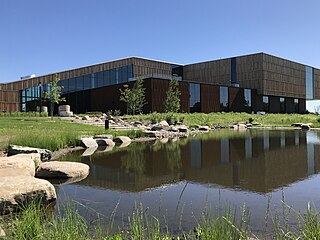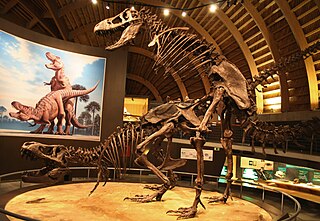Hosted by actor Tom Cavanagh, Stories from the Vaults is a series of 30-minute shows featuring a behind-the-scenes look at the Smithsonian Institution, the world's largest museum complex. The new series, produced by Caragol Wells Productions, showcases the Smithsonian's rarest treasures as Tom Cavanagh meets with the experts behind the Smithsonian and discusses what it takes to preserve these precious artifacts for the generations to come. Stories from the Vaults debuted September 2007 on Smithsonian Networks. The second season premiered Sunday July 12, 2009.
Cavanagh visits with Dr. Hans-Deiter Seus and collections manager Linda Gordon who oversee 580,000 mammal specimens. They discuss the science of tracking environmental and ecological changes and examine the Smithsonian's vast collection of specimens. Cavanagh also stops by to see the Entertainment Collection curator to enjoy a collection of jokes donated by the first woman to enjoy a comedy career in television.
Tom Cavanagh goes in search of the most misunderstood, the best and the tiniest to learn what it takes to stand out in a collection of 142 million objects. Paul Rhymer discusses the art of taxidermy with Tom before Cavanagh heads over to the National Museum of American History for a unique test. In a "cello challenge" Cavanagh has to identify the difference in sound between an ordinary cello and that of a 300-year-old Stradivarius, one of the finest instruments in the world.
In "No Place Like Home", Tom examines four unique forms of homes: the earliest space suits, the tipi of the plains Indians, mobile homes, and the life of the roundworm – a parasite able to make its home in almost any type of ecosystem.
Beauty comes in many forms and in this episode Tom Cavanagh explores the subject through the perspective of three Smithsonian curators and their views on ants, orchids and the world of advertising.
In the world of technological innovation there are many important firsts. Join Tom Cavanagh as he examines the cockpit of a jumbo jet, Thomas Edison's earliest light bulbs, and the first video game consoles ever invented.
At the Smithsonian, many researchers and historians find valuable clues about life through the study of death. From a colony of flesh-eating beetles to the idea seeking immortality by posing for a portrait, the Smithsonian presents many ways to answer the question, "Is there life after death?"
The Smithsonian collection is anything but random. Each of its objects has a scope that encompasses answers to questions as yet unasked, from photography, providing a multiplicity of meaning a single image, to the National Zoo, housing animals and DNA for study in future centuries.
Learn how to cook Native American dishes with the executive chef of Mitsitam Café; discover the origins of the American coffee break at the National Museum of American History and visit the National Museum of Dentistry, where host Tom Cavanagh learns how food takes a toll on our teeth.
The Smithsonian's most compelling mysteries are revealed. Can an artist outsmart the world's top spies? How does a missile filled with mail make a political statement to the world? These questions are answered.
The Smithsonian Tropical Research Institute in Panama tracks sloths. Then search the Panama Canal for clues to the creation of the Panamanian Isthmus, and rise sixteen stories atop the rainforest in a construction crane to do bug research.
The Smithsonian's Vaults and labs feature designers who have shaped our future, sneak a peek at museum of the future, and talk to scientists helping to preserve the future of the tropical rainforest.
This episode goes behind the scenes and see what might be called "extreme conservation": like saving animals from the brink of extinction; finding new ways to preserve a provocative work of art; or reviving an entire genre of music. Also learn what Smithsonian experts are doing to protect the best aspects of our world for future generations.
People may not like to talk about it, but sex is everywhere ... even at the Smithsonian. The topic may not be featured in major museum exhibitions, but the vaults and labs of the Smithsonian feature stories about "the birds and the bees." Host Tom Cavanagh goes behind the scenes of the Smithsonian to find evidence of romance and sex.
Explore the crime "scene" at the Smithsonian's Vaults: photographic evidence from the Crime of the Century; everyone's favorite natural villain, the snake; and America's first "Lone Gunman": John Wilkes Booth.

Eanger Irving Couse was an American artist and a founding member and first president of the Taos Society of Artists. Born and reared in Saginaw, Michigan, he went to New York City and Paris to study art. While spending summers in Taos, New Mexico, he began to make the paintings of Native Americans, New Mexico, and the American Southwest for which he is best known. He later settled full time in Taos.

Nam June Paik was a Korean American artist. He worked with a variety of media and is considered to be the founder of video art. He is credited with the first use (1974) of the term "electronic super highway" to describe the future of telecommunications.

A curator is a manager or overseer. When working with cultural organizations, a curator is typically a "collections curator" or an "exhibitions curator", and has multifaceted tasks dependent on the particular institution and its mission. The term "curator" may designate the head of any given division, not limited to museums. Curator roles include "community curators", "literary curators", "digital curators", and "biocurators".

David Michael Wojnarowicz ( VOY-nə-ROH-vitch was an American painter, photographer, writer, filmmaker, performance artist, songwriter/recording artist, and AIDS activist prominent in the East Village art scene. He incorporated personal narratives influenced by his struggle with AIDS as well as his political activism in his art until his death from the disease in 1992.

The Anacostia Community Museum is a community museum in the Anacostia neighborhood of Washington, D.C., in the United States. It is one of twenty museums under the umbrella of the Smithsonian Institution and was the first federally funded community museum in the United States. The museum, founded in 1967, was created with the intention to bring aspects of the Smithsonian museums, located on the National Mall, to the Anacostia neighborhood, with the hope that community members from the neighborhood would visit the main Smithsonian museums. It became federally funded in 1970 and focuses on the community in and around Anacostia in its exhibitions. This museum also houses a library.

Thomas Cavanagh is a Canadian actor. He is known for a variety of roles on American television, including starring roles in Ed (2000–2004), Love Monkey (2006) and Trust Me (2009), and recurring roles on Providence and Scrubs. From 2014 to 2023, he portrayed Eobard Thawne / Reverse-Flash and the various versions of Harrison Wells on The CW television series The Flash; Cavanagh also directed several episodes of The Flash. In 2023, he became the host of Hey Yahoo on GSN.

The Florida Museum of Natural History (FLMNH) is Florida's official state-sponsored and chartered natural-history museum. Its main facilities are located at 3215 Hull Road on the campus of the University of Florida in Gainesville.

The Buffalo Bill Center of the West, formerly known as the Buffalo Bill Historical Center, is a complex of five museums and a research library featuring art and artifacts of the American West located in Cody, Wyoming. The five museums include the Buffalo Bill Museum, the Plains Indians Museum, the Whitney Western Art Museum, the Draper Natural History Museum, and the Cody Firearms Museum. Founded in 1917 to preserve the legacy and vision of Col. William F. "Buffalo Bill" Cody, the Buffalo Bill Center of the West is the oldest and most comprehensive museum complex of the West.

The Science Museum of Minnesota is an American museum focused on topics in technology, natural history, physical science, and mathematics education. Founded in 1907 and located in Saint Paul, Minnesota, the 501(c)(3) nonprofit institution has 385 employees and is supported by volunteers.

The Bell Museum, formerly known as the James Ford Bell Museum of Natural History, is located at the University of Minnesota. The museum's new location on the St. Paul campus opened in 2018. The Minnesota wildlife dioramas showcase animal specimens from around the world. The museum also houses the 120-seat digital Whitney and Elizabeth MacMillan Planetarium. The museum is part of the university's College of Food, Agricultural and Natural Resource Sciences. The museum's former location in Minneapolis is closed in January 2017.
The Smithsonian Channel is an American pay television channel owned by Paramount Global through its media networks division under MTV Entertainment Group. It offers video content inspired by the Smithsonian Institution's museums, research facilities and magazines.

Asia Art Archive (AAA) is a nonprofit organisation based in Hong Kong which focuses on documenting the recent history of contemporary art in Asia within an international context. AAA incorporates material that members of local art communities find relevant to the field, and provides educational and public programming. AAA is one of the most comprehensive publicly accessible collections of research materials in the field. In activating its collections, AAA initiates public, educational, and residency programmes. AAA also offers research grants and publishes articles on IDEAS Journal.

Exhibit design is the process of developing an exhibit—from a concept through to a physical, three-dimensional exhibition. It is a continually evolving field, drawing on innovative, creative, and practical solutions to the challenge of developing communicative environments that 'tell a story' in a three-dimensional space.
Adelyn Dohme Breeskin (1896–1986) was an American curator, museum director, and art historian known for her longtime leadership of the Baltimore Museum of Art and Mary Cassatt scholarship.
The Art Assignment is a PBS Digital Studios webseries focused on contemporary art that debuted in February 2014. The Art Assignment is hosted by Sarah Urist Green who was a curator of contemporary art for the Indianapolis Museum of Art from 2007 to 2013.
Conservation and restoration at the Smithsonian Institution deals with the care of the 138 million artifacts located in the collections of Smithsonian Institution. Work is conducted by one research center, the Museum Conservation Institute (MCI), and by conservators at the Smithsonian's museums, galleries, zoo. Smithsonian conservators provide myriad services to their units, including exhibit preparation of the museum collection and loan objects, advising on object care, training for future generations of conservationists, engaging in routine preventive care on a daily basis, conducting research projects related to the collections, and examining objects for evidence of manufacturing techniques and previous restorations All conservation labs collectively further the mission of the Smithsonian Institution, "the increase and diffusion of knowledge." Founded in 1846 the Smithsonian is the world's largest museum and research complex, consisting of 19 museums and galleries, the National Zoological Park, and nine research facilities.

The exhibition of cultural property is a practice used by organizations where collected objects are put on display to the public. The objects are carefully chosen and placed together to offer educational value, and often to tell a story.
The conservation and restoration of performance art is the process of documenting, collecting, and prolonging the life of Performance Art. Performance Art often features a live presentation initially documented by an artist, cultural institution, or host location. This genre of art can take place in a wide range of mediums, and is usually based on four core elements: Time, Space, the Performer's body, and the relationship between viewers and performer. These variables determine how it can be collected and conserved within museums or cultural institutions.
Nicholas Pyenson is a paleontologist and the curator of fossil marine mammals at the Smithsonian Institution’s National Museum of Natural History in Washington, DC. He is the author of numerous popular science works including the book Spying on Whales: The Past, Present, and Future of Earth's Most Awesome Creatures.